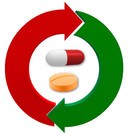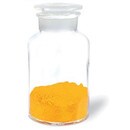Expert opinion
ARA is an essential fatty acid for the development of infants and young children
22 August 2016
01 March 2012
The use of medication worldwide is growing continually, not least because of the rising age of the population. Today there are many people who take more than three different kinds of medication daily (1,2). In highly developed countries, it is particularly common for patients to be prescribed medication long-term, most frequently for the treatment of widespread chronic diseases, such as hypertension, diabetes and hypercholesterolemia. It is also a common practice in those regions to take over-the-counter medicines, including painkillers and medication for stomach ulcers (3,4). When several kinds of medication are taken concomitantly, the risks and side effects increase. In contrast to other adverse drug reactions, the inter-action between medications and micronutrients is only gradually gaining the attention of experts and the wider public. A number of medicines influence the metabolism of vitamins, minerals and trace elements in such a way that they could lead to insufficiencies or even deficiency symptoms in patients (5,6).
 The type and severity of these drug-induced micronutrient imbalances differ de-pending on the sort of micronutrient, the dosage of the pharmaceutical substance and the number of medications taken concomitantly. It is also important to factor in the duration of the therapy and the underlying nutritional status of the patient before the start of therapy. Some pharmaceutical substances interfere with a patient’s nutritional balance indirectly, e.g., by suppressing the appetite or pre-venting micronutrient absorption, while others are direct micronutrient antagonists. Consequently, patients should have their micronutrient status monitored and, if necessary, re-balanced through targeted dietary supplement intake. The following describes the most common drug-induced micronutrient insufficiencies in more detail (1,2).
The type and severity of these drug-induced micronutrient imbalances differ de-pending on the sort of micronutrient, the dosage of the pharmaceutical substance and the number of medications taken concomitantly. It is also important to factor in the duration of the therapy and the underlying nutritional status of the patient before the start of therapy. Some pharmaceutical substances interfere with a patient’s nutritional balance indirectly, e.g., by suppressing the appetite or pre-venting micronutrient absorption, while others are direct micronutrient antagonists. Consequently, patients should have their micronutrient status monitored and, if necessary, re-balanced through targeted dietary supplement intake. The following describes the most common drug-induced micronutrient insufficiencies in more detail (1,2).
 Fat-soluble vitamins and carotenoids
Fat-soluble vitamins and carotenoids
Raised blood cholesterol levels represent a risk factor for widespread cardiovascular diseases, such as heart attack, stroke or peripheral vascular disease, and cholesterol-lowering substances are among the most commonly prescribed drugs. The active substance cholestyramine inhibits the absorption of cholesterol and binds bile acids which aid the digestion and absorption of fat in the small intestine. Since the absorption of dietary fats in the intestine is then limited, the uptake of fat-soluble vitamins A, D, E and K as well as the uptake of carotenoids (e.g., beta-carotene and lycopene) are also negatively affected (2,7).
Today, anti-inflammatory and immunosuppressive corticosteroids (cortisone) are indispensible for treating acute and chronic inflammatory autoimmune diseases like rheumatoid arthritis, Crohn’s Disease and chronic-obstructive pulmonary diseases (COPD), as well as allergic diseases, such as bronchial asthma and atopic dermatitis. However, they do cause side effects when used for long-term treatment. For example, the corticosteroids prednisolone and dexamethasone are vitamin D antagonists: renal calcium elimination is increased while calcium absorption falls, leading to a possible increase in the risk of osteoporosis (8,9). Vitamin D status itself can be impaired by medications for epilepsy therapy. The WHO reports that there are 50 million people suffering from epilepsy all over the world. Epilepsy is a highly complex chronic neurological disorder of the brain (excessive brain activity) that leads to seizures. Its onset can occur at any age. Anti-epileptic drugs and anticonvulsants, which can surpress seizures, i.e., the brain’s epileptic activity, often cause side effects (10). One of these is bone damage: anti-epileptic drugs like carbamazepine, phenobarbital, phenytoin and primidone can cause an increase in biliary elimination of vitamin D, while simultaneously preventing absorption and calcium utilization. In the long term this can lead to vitamin D deficiency which may give rise to weakness of the bones and muscles (myopathy) (11 – 13). Another class of substances with a negative effect on bone metabolism is heparin, which, as an anticoagulant, is routinely used to thin the blood in cases of thrombophilia. It is given to patients after operations to prevent, for example, thrombosis and pulmonary embolism, and to disperse arterial thromboses that have already formed. Conventional heparin can have a negative influence on blood levels of vitamin D3 and calcium. If the therapy lasts for more than four months, the incidence of spontaneous fractures may increase and osteoporosis be induced (14,15).
Conversely, anticoagulants may also be given to promote coagulation in cases of increased risk of bleeding. Phenprocoumon and warfarin are vitamin K antagonists, and inhibit the activity of this vitamin, which is involved in the synthesis of coagulation factors. The anticoagulants can induce vitamin K deficiency, which in turn means that not enough osteocalcin, a bone matrix protein, can be produced. If vitamin K antagonists are taken for longer than 12 months, the risk of fractures rises. Taking warfarin during pregnancy can harm the development of the fetal skeleton and cause severe skeletal anomalies (14,16,17).
 Water-soluble vitamins
Water-soluble vitamins
Many medicines can impair the body’s supply of water-soluble vitamins, especially B-vitamins. Hence, a folic acid deficiency can result from taking the antiepileptic drug phenytoin, as it accelerates the folic acid metabolism while simultaneously inhibiting the folic acid uptake. This can lead to raised homocysteine levels in the blood, an overgrowth of the gums (gingival hyperplasia) and a drop in biotin levels (18, 19). Pregnant epileptic women demonstrate an increased risk of giving birth to a child with defects due to folic acid deficiency (e.g., neural tube defects) and should therefore take folic acid if possible before conception as a preventive measure (20,21). Methotrexate, an antirheumatic drug used to treat rheumatoid arthritis (RA), the most common form of inflammatory arthritis, can also negatively influence folic acid concentrations. Osteoarthritis is the most common disease on the planet. Around 1% of the world’s population suffers from deterioration of the joints and their extremely painful, inflammatory form, RA. Methotrexate is a folic acid antagonist that inhibits key enzymes in folic acid metabolism and can therefore induce folic acid deficits (22).
Diuretics, which support the elimination of water and electrolytes via the kidneys, have a broad range of therapeutic actions and are thus primarily used for treating many widespread diseases, such as heart failure, hypertension and edemas (23,24). Diuretics, especially the loop diuretic furosemide and the potassium-sparing diuretic hydrochlorothiazide/triamterene, cause an increase in the elimination of water-soluble vitamins like B6, B12 and folic acid and lead to insufficiencies in the body. Triamterene can also reduce the uptake of folic acid and its bioavailability (25).
A fall in blood folic acid levels and a rise in homocysteine concentrations can also be caused by constipation medication. Patients suffering from chronic constipation, which affects up to 20% of the adult population, regularly use laxatives that accelerate intestinal voiding. Some, like bisacodyl and sodium picosulfate, inhibit the uptake of sodium and water from the intestine, causing an influx of electrolytes and water-soluble vitamins into the intestine and increasing their rate of excretion (26).
Diabetes mellitus is a common chronic disorder of blood sugar metabolism, which is associated with a significant risk of severe complications and sequelae in the cardiovascular and nervous systems (27,28). The most common form is type 2 diabetes, in which the cells of the body do not utilize insulin efficiently. Treatment often includes substances to improve the organism’s sensitivity to insulin. However, the oral antidiabetic drug metformin hydrochloride, for example, concomitantly lowers blood levels of vitamin B12 and folic acid by reducing their uptake from the gastrointestinal tract, which can exacerbate nervous disorders (neuropathies), like tingling and numbness, especially in the hands and feet of those affected (29,30).
Among the most frequently prescribed drugs in the world are proton pump inhibitors (PPI). These are substances that suppress the production of gastric acid with the aim of preventing gastric ulcers. But PPI not only prevent the production of gastric acid, they also prevent the release and utilization of vitamin B12 from food. And a vitamin B12 deficiency can increase the risk of cognitive disorders and decrease mental capacity, particularly in older patients (31,32,33).
Proton pump inhibitors also reduce the bioavailability of dietary vitamin C (32,34). A further potential disruptive factor to vitamin C status is the painkiller (analgesic) acetylsalicylic acid (ASA): the most frequently used medication with pain-relieving and anti-inflammatory properties worldwide. The mucous membrane of the stomach contains high concentrations of vitamin C. However, ASA can disturb the gastrointestinal vitamin C balance, thus leading to a fall in tissue levels of the vitamin. In addition, a reduction in blood plasma concentrations of vitamin C and an increased elimination of the vitamin in urine have been observed (35,36). Furthermore, studies have found a link between ASA administration and vitamin B12 deficiency (37).
An estimated 235 million children and adults around the world suffer from asthma and the most common children’s afflictions worldwide are bronchial diseases (38). Besides corticosteroids, the active substance theophylline is also used for the treatment of asthma. This substance inhibits the activation of vitamin B6 and can thus lead to a fall in blood vitamin B6 concentrations and a rise in homocysteine levels (39).
 Minerals and trace elements
Minerals and trace elements
Besides influencing the concentration of water-soluble vitamins in the blood, a mid- to long-term therapy with proton pump inhibitors (PPI) can also impair the absorption and utilization of calcium. PPI reduce the production of gastric acid, which plays an important role in the uptake of calcium. In foodstuffs, calcium is primarily found in the form of a calcium carbonate compound that does not dissolve readily and must be released from this compound form by gastric acid before it can be absorbed by the organism. Hence PPI therapy can lead to reduced bioavailability of calcium and in consequence to disturbances in vitamin D metabolism, which may be associated with an increased risk of fractures (40,41). PPI can also reduce the uptake of iron from food (non-heme iron), which – particularly for those with a vegetarian diet – can lead to a disturbance in the production of red blood corpuscles (anemia) (42). Furthermore, PPI can impair the active and passive absorption of magnesium and hence, in the long term, increase the risk of severe deficiency states (43). PPI of the H2-receptor antagonists (e.g., cimetidine and ranitidine) inhibit histamine-stimulated acid production in the gastric mucosa, which can reduce the bioavailability and absorption of iron and zinc (33).
Due to their stimulation of water elimination via the kidneys, diuretics, especially when used to lower blood pressure, flush large quantities of potassium and magnesium out of the body. However, deficiencies of these two micronutrients can encourage cardiac arrhythmias and promote insulin resistance (33). Laxatives, such as bisacodyl and sodium picosulfate, can also give rise to an electrolyte imbalance by increasing elimination of sodium, potassium, magnesium and calcium. But potassium deficiency also impairs colon peristalsis and if the intestinal muscles are not sufficiently mobile, intestinal voidance is obstructed, which can lead once again to constipation (44).
Depression is one of the most widespread diseases in the world (45). Lithium salts have proved effective in the treatment of depression and mania. However, lithium disturbs the storage of iodine in the thyroid and the selenium balance. Selenium deficiency in turn reinforces the effect of iodine deficiency, so that lithium therapy may lead to goiter (struma) or to an autoimmune disease of the thyroid (Hashimoto’s thyroiditis) (46,47,48).
Statins (e.g., lovastatin and pravastatin) are standard medications for the treatment of high blood cholesterol levels. They block the key enzyme for cholesterol synthesis, which can lead to reduced synthesis of various selenoproteins – e.g., selenoprotein N, which is involved in muscle cell regeneration. The muscle pains that are typical side-effects of statin therapy are linked with this activity (49).
 Coenzyme Q10
Coenzyme Q10
Statins inhibit synthesis not only of cholesterol but also of other biomolecules, like coenzyme Q10. Hence statin therapy can lead to a substantial drop in the blood serum concentration of coenzyme Q10 and to a decrease in cellular coenzyme Q10 concentration. Coenzyme Q10 deficiency can disturb muscle energy metabolism, with symptoms including fatigue, amyosthenia and myopathy (50).
22 August 2016
7 September 2010
Giving iron supplements to children with low birth weights may reduce the risk of developing iron deficiency and anemia, a new Swedish study suggests.
19 December 2011
Regular supplementation with eicosapentaenoic acid may be more effective in preventing heart attacks in men than in women, a new Australian study says.